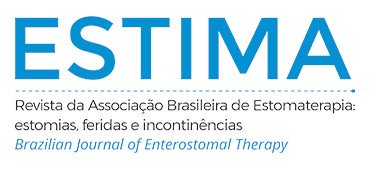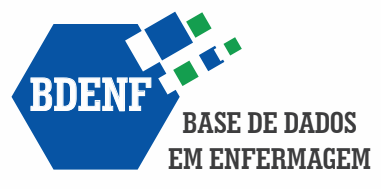SELF-ASSESSMENT OF PRIMARY CARE NURSES ABOUT CARE FOR PEOPLE WITH VENOUS ULCERS: A CROSS-CUTTING STUDY
Abstract
Objective: To identify the self-knowledge of primary care nurses about care for people with venous ulcers. Method: This is a cross-sectional study with 40 nurses working in health units. Two data collection instruments were used: characterization, developed by the author, and self-assessment on venous ulcers. Results: All questions of the self-assessment instrument reached medians classified as little level of knowledge, except questions related to the application of elastic compression therapy, with the median = 3 (moderate), and the evaluation of lower limbs to investigate arterial involvement, with 3.50, between little and moderate. The item cleaning the lesion stood out, which obtained median = 4 (little) and the highest average found in the responses, 4.03 (little). Conclusion:The nurse’s self-assessment reached moderate and low scores of clinical practice in terms of knowing (theoretical knowledge) and doing (practical knowledge) in the care of people with venous ulcers. Venous ulcer is a complex wound and requires knowledge from nurses about the pathophysiology and appropriate treatment, interfering with the improvement of the person’s quality of life. It is believed that this study can encourage the reflection of this professional and education actions in the services.
Downloads
Metrics
References
Sánchez-Nicolat NE, Guardado-Bermúdez F, Arriaga-Caballero JE, Torres-Martínez JA, Flores-Escartín M, Serrano-Lozano JA, et al. Revisión en úlceras venosas: Epidemiología, fisiopatología, diagnóstico y tratamiento actual. Rev Mex Angiol 2019;47(1):26-38.
Torres SMDSSO, Araújo ROE, Costa IKF, Tibúrcio MP, Sousa AJG, Pergola-Marconato AM, et al. Health-related quality of life in patients with venous leg ulcer treated in primary care in Brazil and Portugal. PLoS One 2018;13(4). https://doi.org/10.5281/zenodo.1218356
Raffetto JD, Ligi D, Maniscalco R, Khalil RA, Mannello F. Why venous leg ulcers have difficulty healing: overview on pathophysiology, clinical consequences, and treatment. J Clin Med 2020;10(1):29. https://doi.org/10.3390/jcm10010029
Borges EL, Nascimento Filho HM, Pires Júnior JF. Prevalence of chronic wounds in a city of Minas Gerais (Brazil). Rev Min Enferm. 2018;22:e1143. https://doi.org/10.5935/1415-2762.20180074
Brasil. Portaria nº 2.436, de 21 de setembro de 2017. Aprova a Política Nacional de Atenção Básica, estabelecendo a revisão de diretrizes para a organização da Atenção Básica, no âmbito do Sistema Único de Saúde. Diário Oficial da União. 2017;Seção 1.
Cortez DN, Moraes JT, Ferreira IR, Silva EL, Lanza FM. Custos do tratamento de lesões cutâneas na Atenção Primária à Saúde. ESTIMA, Braz. J. Enterostomal Ther 2019;17(1):e2419. https://doi.org/10.30886/estima.v17.824_IN
Osmarin VM, Boni FG, Bavaresco T, Lucena AF, Echer IC. Uso da Nursing Outcomes Classification - NOC para avaliar o conhecimento de pacientes com úlcera venosa. Rev Gaúcha Enferm 2021;41(Esp.):e20190146. https://doi.org/10.1590/1983-1447.2020.20190146
Sousa ATO, Formiga NS, Oliveira SHS, Torres GVT, Costa MML, Soares MJGO. Validating an instrument to assess nurse knowledge related to preventing and treating individuals with venous ulcer. Invest Educ Enferm 2016;34(3):433-43. https://doi.org/10.17533/udea.iee.v34n3a02
Shoji S, Souza NVDO, Maurício VC, Costa CCP, Alves FT. O cuidado de enfermagem em Estomaterapia e o uso das tecnologias. ESTIMA, Braz. J. Enterostomal Ther 2017;15(3):169-7. https://doi.org/10.5327/Z1806-3144201700030008
Norman G, Westby MJ, Rithalia AD, Stubbs N, Soares MO, Dumville JC. Dressings and topical agents for treating venous leg ulcers. Cochrane Database Syst Rev 2018;6(6):CD012583. https://doi.org/10.1002/14651858.CD012583.pub2
Shaydakov ME, Ting W, Sadek M, Aziz F, Diaz JA, Raffetto JD, et al. Review of the current evidence for topical treatment for venous leg ulcers. J Vasc Surg Venous Lymphat Disord 2022;10(1):241-7. https://doi.org/10.1016/j.jvsv.2021.06.010
Oliveira BGRB, Castro JB, Granjeiro JM. Panorama epidemiológico e clínico de pacientes com feridas crônicas tratados em ambulatório. Rev Enferm 2013;21(5):612-7.
Mościcka P, Szewczyk MT, Cwajda-Białasik J, Jawień A. The role of compression therapy in the treatment of venous leg ulcers. Adv Clin Exp Med 2019;28(6):847-52. https://doi.org/10.17219/acem/78768
Oates A, Adderley U. Survey of registered nurses’ selection of compression systems for the treatment of venous leg ulcers in the UK. J Tissue Viability 2019;28(2):115-9. https://doi.org/10.1016/j.jtv.2019.02.004
Caveião C, Hey AP, Sales WB, Tavares ELP, Souza E, Silva MMBG. Conhecimento do enfermeiro da atenção primária à saúde sobre a indicação de coberturas especiais. ESTIMA, Braz J Enterostomal Ther 2018;16(2):e3118. https://doi.org//10.30886/estima.v16.562_PT
McLain NEM, Moore ZEH, Avsar P. Wound cleansing for treating venous leg ulcers. Cochrane Database Syst Rev 2021;(3):CD011675. https://doi.org//10.1002/14651858.CD011675.pub2
Murphy C, Atkin L, Vega de Ceniga M, Weir D, Swanson T, Walker A, et al. International consensus document. Embedding Wound Hygiene into a proactive wound healing strategy. J Wound Care 2022;31(Supl.4a):S1-S19. https://doi.org/10.12968/jowc.2022.31.sup4a.s1
Rocha MNB, Serna Gonzalez CV, Borges EL, Santos VLCG, Rabeh SAN, Nogueira PC. Incidence of recurrent venous ulcer in patients treated at an outpatient clinic: historical cohort. Int J Low Extrem Wounds 2022:15347346211065929. https://doi.org/10.1177/15347346211065929
Mościcka P, Szewczyk MT, Cwajda-Białasik J, Jawień A. The role of compression therapy in the treatment of venous leg ulcers. Adv Clin Exp Med. 2019;28(6):847-52. https://doi.org/10.17219/acem/78768
Phillips CJ, Humphreys I, Thayer D, Elmessary M, Collins H, Roberts C, et al. Cost of managing patients with venous leg ulcers. Int Wound J 2020;17(4):1074-82. https://doi.org/10.1111/iwj.13366
Galindo Neto NM, Carvalho GCN, Castro RCMB, Caetano JA, Santos ECB, Silva TM, et al. Vivências dos professores acerca dos primeiros socorros na escola. Rev Bras Enferm 2018;71(Supl. 4):1678-84. https://doi.org/10.1590/0034-7167-2017-0715
Souza FJ, Aquino JFST, Silva MAG, Oliveira MF, Dantas SRPE. Noninvasive measures of venous ulcer recurrence prevention: integrative review. ESTIMA, Braz J Enterostomal Ther 2019;17:e1119. https://doi.org/10.30886/estima.v17.713_IN
Borges EL, Ferraz AF, Carvalho DV, Matos SS, Lima VLAN. Prevention of varicose ulcer relapse: a cohort study. Acta Paul Enferm 2016;29(1):9-16. https://doi.org/10.1590/1982-0194201600003
Liberato SMD, Araújo RO, Souza AJG, Marconato AMP, Costa IKF, Torres GV. Adesão ao tratamento de pessoas com úlceras venosas atendidas na atenção primária à saúde. Aquichán 2017;17(2):128-39. https://doi.org/10.5294/aqui.2017.17.2.2
Downloads
Published
How to Cite
Issue
Section
License
Copyright (c) 2022 Amanda Ferreira de Almeida Colombi, Eline Lima Borges, Fabiana Gonring Xavier, Maria Edla de Oliveria Bringuente, Thiago Nascimento do Prado

This work is licensed under a Creative Commons Attribution 4.0 International License.

























